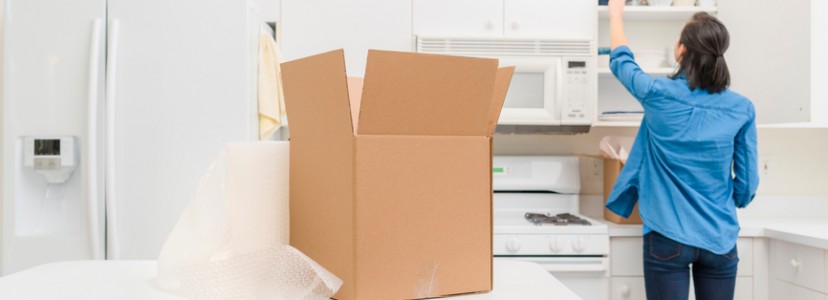How to Safely Package up Your Kitchen

Moving home is an epic task, and getting everything packed away safely can be stressful. You don’t want to end up in your new home with boxes full of broken goods, so taking care to package your items safely is well worth the time.
With kitchens in particular, getting it right from the off will save you a lot of stress and time. You’re dealing with many items that are breakable, such as plates and electrical goods, as well as utensils that could be dangerous if they are not adequately wrapped and protected.
Whether you’re relocating your family, or moving from one student home to another, getting the right moving boxes is an important start. You can beg your local supermarket for their leftovers, but a simpler solution is to consider a ready-made house moving kit; complete with strengthened boxes, and packaging materials of different sizes. So, with that in mind, how do you safely package up your kitchen for an efficient move?
Always take extra care when you are packing sharp knives: you don’t want them to injure you or anyone carrying your moving boxes. Use paper or bubble wrap to wrap them each individually and do so with the blades facing away from you. You will then want to wrap the individually wrapped knives all together, to make it easier to unpack at the other end. With the rest of your cutlery, pack like with like, so that all the forks are kept together, and so are the spoons, and so on. As with the knives, use packing paper or bubble wrap to provide extra protection against scratches.
Make sure you mark the cardboard box your knives and cutlery go in with ‘Sharp!’, so that anyone carrying and unpacking them takes extra care. Also, remember that children should never be involved in the packaging process when sharp items like knives are involved. It’s far too dangerous when you have a large number of knives out of their normal storage space.
Packing up plates and crockery
When you arrive in your new home, the last thing you want is to find that your plates and bowls are cracked or chipped. They can break very easily, so packaging them correctly is especially important. What’s more, crockery can get heavy very quickly so make sure the box you are using is reinforced and strong. Tape the bottom if you have any doubts, but a good quality double wall box. should do the trick.
Next, put a sheet of bubble wrap in the bottom of the box before you add a plate or bowl. Do this individually, and cover again with more bubble wrap. Carry on until all your plates are stacked, each separated and protected by bubble wrap. Wrap piles of three plates with foam packaging if you want extra protection.
You may also want to use packing peanuts to prevent the plates from sliding around in the moving van or when being carried. This will further help to prevent damage during transit, and don’t forget to mark the box as ‘fragile’.
Packing up glass bottles
In our kitchen packing kit, we include four bottle boxes, because we know that wrapping and packing glass bottles of wine, spirits, or oil is tricky. Don’t skimp on the bubble wrap or newspaper for added protection, but this kind of bottle box is an effective way of transporting glass bottles around.
Packing up pots and pans
When you package up your pots and pans, you don’t want them to scratch each other during the journey. Using an old newspaper to line the base of a packing box is a brilliant budget tip, then place your biggest pan in the bottom. Next, place a page of newspaper over the opening, and push the next size pan down so that it is nested in the first. Continue this until all the pans have been nested together, then gather the corners of the newspaper together and tape them together to provide added protection at the top.
Packing up appliances
With large and expensive appliances, such as microwaves and slow cookers, you really don’t want any breakage or damage to occur during your move. Start by padding the base of your box with scrunched up newspaper or packing peanuts. Take any loose items away, such as the glass plate in the microwave base, lids, or breakable elements on other pieces of equipment and package these separately. Wrap them in bubble wrap or packaging tissue for extra protection.
Place the appliance in the box and fill up as much of the empty space as possible with packing peanuts and bubble wrap to prevent the device from moving around during transit. Label the boxes as fragile and tape them up carefully. Keep children out of the way when you are dealing with these heavy and awkwardly shaped items, for obvious safety reasons.
Types of moving boxes available
Boxes vary in size, shape, and strength, as well as the material they are made out of. Sturdy cardboard boxes are great staples for packing for a house move as they are strong and can be packed, sealed and labelled easily. Don’t fall into the trap of thinking that large boxes are always best. Sometimes, snugly fitting items into a smaller box keeps them safer as they are not moving around when they are carried.
Head here if you want more information on the types of boxes you might need for moving home.
Rebecca Price
Latest posts by Rebecca Price (see all)
- The Benefits of Jiffy Bags and Alternative Products You Should Buy - 22nd September 2022
- The Importance of Warehouse Insulation - 25th August 2022
- Davpack’s Guide to Sustainable Loose Fill Packaging - 19th July 2022

